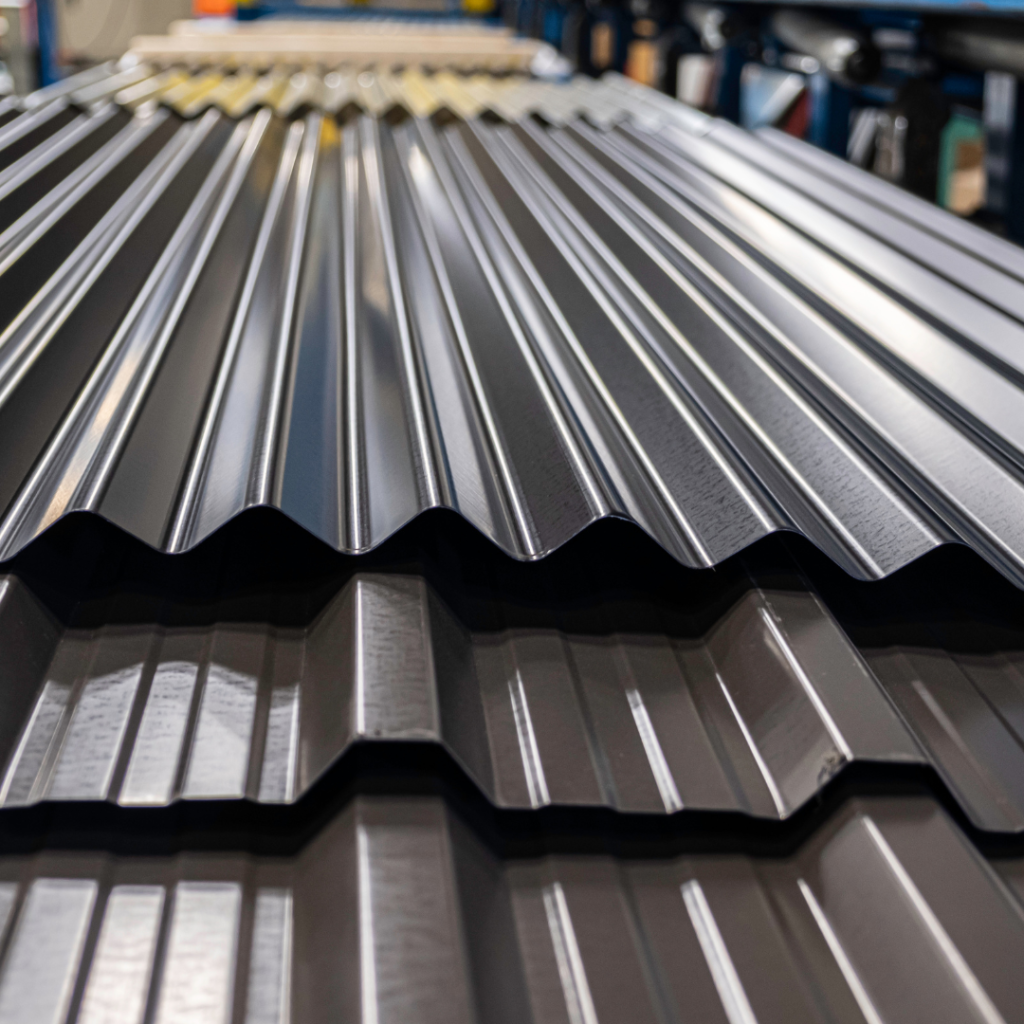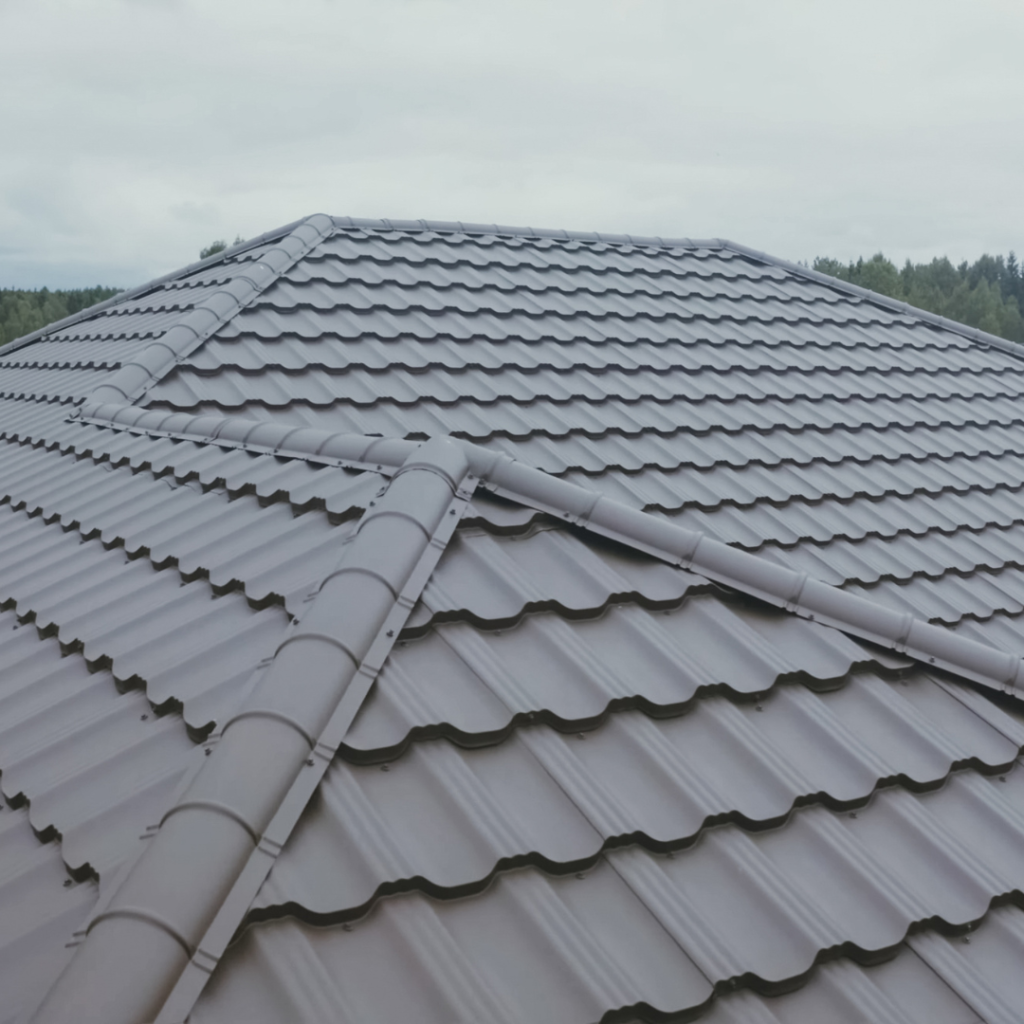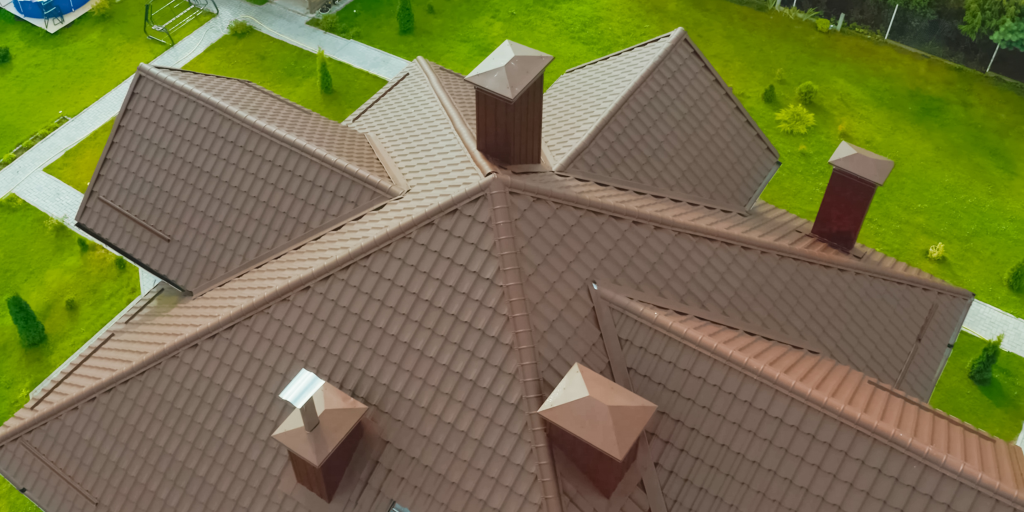Metal Roofs
Metal roofs are renowned for their durability, longevity, and resistance to various environmental factors. Made from materials such as steel, aluminum, copper, and zinc alloys, these roofs can last between 40-70 years or more with proper maintenance in Alma, AR. They are impervious to fire, rot, and insect damage, making them ideal for diverse climates. Metal roofs come in various styles, colors, and finishes, catering to both functional and aesthetic needs.
Historically, metal roofs date back to ancient times, with notable examples like the Pantheon in Rome. Technological advancements over the centuries have improved their efficiency and performance. Modern metal roofs benefit from innovations such as corrugation, galvanization, and advanced coatings, enhancing their weather resistance and energy efficiency.
Installation involves careful planning, material selection, and adherence to proper techniques to ensure a secure and long-lasting roof. Regular maintenance, including inspections and cleaning, is crucial for extending the roof’s lifespan. Metal roofs also offer sustainability advantages, being fully recyclable and often made from recycled materials. These characteristics make metal roofs a cost-effective, eco-friendly, and reliable choice for both residential and commercial applications.
What is a Metal Roof?
Overview of Metal Roofing
A metal roof is a roofing system made from metal pieces or tiles characterized by its high resistance, impermeability, and longevity. Commonly used metals include steel, aluminum, copper, and zinc alloys. Metal roofs are known for their durability and long lifespan, often lasting 40-70 years or more with proper maintenance. They are also resistant to fire, rot, and insect damage, making them a reliable choice for various climates and conditions. Metal roofs are available in a wide range of styles, colors, and finishes, allowing homeowners to achieve both functional and aesthetic goals.
Common Materials Used
Several materials are commonly used in metal roofing, each offering unique benefits and characteristics:
- Steel: Steel is one of the most widely used materials for metal roofing due to its strength and durability. It is typically coated with a layer of zinc or a combination of zinc and aluminum to prevent rust and corrosion, known as galvanized or galvalume steel.
- Aluminum: Aluminum is lightweight, resistant to corrosion, and ideal for coastal environments. It does not rust, making it a durable option for homes in areas with high humidity and salt exposure.
- Copper: Copper roofs are prized for their aesthetic appeal and longevity. Over time, copper develops a natural patina that protects the metal and provides a distinctive appearance. Copper is highly durable and can last over 100 years.
- Zinc: Zinc is known for its self-healing properties, which allow scratches and imperfections to recover over time. Zinc roofs are durable, environmentally friendly, and can last up to 100 years.
- Tin: Historically used in early American homes, tin roofs are less common today but still valued for their durability and rustic charm.
History and Evolution
Origins of Metal Roofing
The origins of metal roofing date back thousands of years, with evidence of metal roofs being used in ancient civilizations. Early examples include copper roofing on the Loha Maha Paya temple in Sri Lanka around 300 B.C. and the copper roof of the Pantheon in Rome, built around 27 B.C. Metal roofing materials were prized for their durability, longevity, and ability to be shaped into various forms. Throughout the centuries, metal roofing evolved with advancements in metallurgy and construction techniques, becoming a symbol of resilience and architectural beauty.
Key Developments in Metal Roofing Technology
Several key developments have marked the evolution of metal roofing technology:
Introduction of Corrugated Iron (1820s): The invention of corrugated iron sheets revolutionized metal roofing by providing a lightweight, strong, and easy-to-install material. This innovation significantly increased the popularity of metal roofs for industrial and agricultural buildings.
Galvanization Process (1830s): The development of the galvanization process, which involves coating iron or steel with a protective layer of zinc, greatly enhanced the durability and corrosion resistance of metal roofs. This advancement made metal roofing more accessible and practical for a wider range of applications.
Standing Seam Metal Roofs (1950s): The introduction of standing seam metal roofs offered improved weather resistance and a sleek, modern appearance. The design features interlocking seams that are raised above the roof surface, providing superior protection against water infiltration.
Advancements in Coatings and Finishes (1970s-Present): Technological advancements in coatings and finishes have further enhanced the performance and aesthetics of metal roofs. Modern metal roofs can be coated with various materials, such as polyvinylidene fluoride (PVDF) or acrylic, to improve UV resistance, color retention, and overall durability. Additionally, the development of reflective coatings has contributed to the energy efficiency of metal roofs.
Environmental Considerations (2000s-Present): Increasing awareness of environmental sustainability has led to the use of more recycled materials in metal roofing and the promotion of metal roofs for their recyclability and energy efficiency. Innovations in manufacturing processes have also reduced the environmental impact of producing metal roofing materials.
These developments have transformed metal roofing into a versatile and high-performance option, suitable for a wide range of residential, commercial, and industrial applications.
Types of Metal Roofs
Standing Seam Metal Roofs
Standing seam metal roofs are a popular and highly durable roofing option. They feature vertical panels with interlocking seams that are raised above the roof surface. This design provides excellent weather resistance, preventing water infiltration and ice dam formation. Standing seam metal roofs are known for their sleek, modern appearance and are often used in residential, commercial, and industrial buildings. They are typically made from materials such as steel, aluminum, or copper, and can be coated with various finishes to enhance durability and aesthetics. The long lifespan and low maintenance requirements make standing seam metal roofs a cost-effective and reliable choice for many homeowners.
Metal Shingles and Tiles
Metal shingles and tiles offer the traditional look of shingles or tiles with the added benefits of metal roofing. These roofing options can mimic the appearance of materials like wood, slate, or clay, providing versatility in design while maintaining the durability and longevity of metal. Metal shingles and tiles are available in various styles, colors, and textures, allowing homeowners to achieve their desired aesthetic. They are often made from materials such as steel, aluminum, or copper and can be coated with protective finishes to enhance weather resistance and color retention. Metal shingles and tiles are lightweight, easy to install, and require minimal maintenance, making them an attractive option for both new constructions and roof replacements.

Corrugated Metal Roofs
Corrugated metal roofs are characterized by their distinctive wavy pattern, which provides strength and durability. These roofs are commonly used in agricultural, industrial, and commercial applications but are also suitable for residential use. The corrugated design allows for excellent water runoff and adds structural rigidity, making it a resilient roofing option. Corrugated metal roofs are typically made from galvanized steel or aluminum, offering good resistance to corrosion and weather damage. They are lightweight, easy to install, and cost-effective, making them a practical choice for various building types. The simplicity and robustness of corrugated metal roofs ensure long-lasting performance with minimal maintenance.
Installation Process
Preparation and Planning
Proper preparation and planning are crucial for the successful installation of a metal roof. Start by inspecting the existing roof structure to ensure it is in good condition and capable of supporting a metal roof. Address any necessary repairs or reinforcements. Obtain all required permits and check local building codes to ensure compliance. Measure the roof accurately to determine the amount of materials needed, and order extra to account for waste and errors. Finally, choose the right type of metal roofing and finish based on your specific needs and aesthetic preferences.
Step-by-Step Installation Guide
The step-by-step installation process of a metal roof includes:
Remove Old Roofing: Remove the old roofing material and inspect the roof deck for any damage. Repair or replace any damaged sections to ensure a solid foundation for the new roof.
Install Underlayment: Lay down a waterproof underlayment over the entire roof deck. This provides an additional layer of protection against moisture.
Install Flashing: Install flashing around roof edges, chimneys, vents, and any other roof penetrations. Flashing helps prevent water from seeping into the roof at these vulnerable points.
Lay the First Panels: Start at one end of the roof and lay the first metal panels, ensuring they are properly aligned and overlap according to the manufacturer’s instructions. Secure the panels with the appropriate fasteners.
Continue Installing Panels: Continue laying panels, working your way across the roof. Make sure each panel overlaps the previous one and is securely fastened. Pay close attention to seams and ensure they are sealed properly to prevent leaks.
Install Ridge Caps: Once all panels are in place, install the ridge caps along the roof’s peak. Ridge caps cover the seams where panels meet at the peak, providing a finished look and additional protection against water infiltration.
Final Inspection and Cleanup: Inspect the entire roof to ensure all panels are secure and properly installed. Check for any loose fasteners or gaps. Clean up any debris and ensure the roof area is free of hazards.
Required Tools and Materials
The tools and materials required for installing a metal roof include:
Metal roofing panels
Waterproof underlayment
Flashing
Ridge caps
Roofing fasteners (screws or nails)
Roofing sealant
Measuring tape
Chalk line
Hammer or nail gun
Screwdriver or drill
Tin snips or metal cutting tools
Ladder and safety equipment (harness, gloves, etc.)
Having the right tools and materials on hand is essential for a smooth and efficient installation process.
Maintenance and Care
Routine Maintenance Tips
Regular maintenance is essential to ensure the longevity and performance of a metal roof. Here are some routine maintenance tips:
- Regular Inspections: Conduct bi-annual inspections, ideally in the spring and fall. Look for signs of damage, such as loose or missing fasteners, rust spots, and damaged panels.
- Clean Gutters and Downspouts: Ensure gutters and downspouts are clear of debris to prevent water backup and potential roof damage. Clean them regularly to maintain proper water drainage.
- Remove Debris: Clear leaves, branches, and other debris from the roof surface. Accumulated debris can trap moisture and cause corrosion or damage to the roof.
- Trim Overhanging Branches: Trim any tree branches that hang over the roof to prevent damage from falling limbs and reduce debris buildup.
- Wash the Roof: Periodically wash the roof with a gentle detergent and water to remove dirt, mold, and mildew. Avoid using harsh chemicals or abrasive tools that could damage the roof’s finish.
Identifying and Addressing Common Issues
Promptly identifying and addressing common issues can extend the life of a metal roof and maintain its effectiveness:
- Loose or Missing Fasteners: Check for loose or missing fasteners during inspections. Tighten or replace them to ensure the roof panels remain securely attached.
- Rust and Corrosion: Inspect for rust or corrosion, especially in areas where water tends to accumulate. Remove any rust with a wire brush and apply a rust-resistant primer and paint to prevent further corrosion.
- Damaged Panels: Look for signs of damage, such as dents, scratches, or punctures. Minor damage can be repaired with sealant or patch kits, while severely damaged panels may need to be replaced.
- Leaks: Check for leaks inside the attic or under the roof. Pay special attention to areas around roof penetrations like chimneys, vents, and skylights. Seal any leaks with roofing sealant or replace damaged flashing as needed.
- Fading or Chalking: Over time, the roof’s finish may fade or chalk due to exposure to UV rays. While this typically doesn’t affect performance, you can apply a fresh coat of paint or protective coating to restore the roof’s appearance and provide additional protection.
By following these maintenance and care tips, homeowners can ensure their metal roofs remain in excellent condition, providing reliable protection and longevity.
Durability and Lifespan
Expected Lifespan of Metal Roofs
Metal roofs are renowned for their exceptional durability and long lifespan. On average, a well-installed and maintained metal roof can last between 40 to 70 years, and some materials, like copper and zinc, can last well over 100 years. This longevity far exceeds that of traditional roofing materials such as asphalt shingles, which typically last 20 to 30 years. The extended lifespan of metal roofs makes them a cost-effective investment over time, reducing the need for frequent replacements and extensive repairs.

Factors Affecting Longevity
Several factors can influence the longevity of a metal roof:
Quality of Materials: The type and quality of metal used significantly impact the roof’s durability. High-quality metals such as galvanized steel, aluminum, copper, and zinc are more resistant to corrosion, weather damage, and wear.
Installation Practices: Proper installation is crucial for maximizing the lifespan of a metal roof. Incorrect installation can lead to issues such as leaks, rust, and structural damage. Hiring experienced and certified roofing contractors ensures the roof is installed correctly and securely.
Climate and Environmental Conditions: The climate and environment where the roof is installed play a vital role in its longevity. Metal roofs are highly resistant to various weather conditions, but extreme climates can still affect their durability. For example, coastal areas with high salt exposure may accelerate corrosion, while regions with heavy snowfall may increase the risk of ice dam formation.
Maintenance and Care: Regular maintenance is essential to prolong the life of a metal roof. Routine inspections, cleaning, and timely repairs help prevent minor issues from escalating into significant problems. Addressing issues like rust spots, loose fasteners, and damaged panels promptly can greatly extend the roof’s lifespan.
Roof Design and Slope: The design and slope of the roof can affect its durability. Steeper slopes facilitate better water runoff, reducing the risk of water pooling and corrosion. Proper ventilation and insulation also help in maintaining the roof’s integrity by preventing moisture buildup and thermal stress.
Coatings and Finishes: The use of protective coatings and finishes can enhance the durability of a metal roof. Coatings like polyvinylidene fluoride (PVDF) and acrylic improve UV resistance, color retention, and corrosion resistance, contributing to a longer lifespan.
By considering these factors and taking proactive measures, homeowners can maximize the durability and lifespan of their metal roofs, ensuring long-lasting protection and value.
Sustainability of Metal Roofing Materials
Metal roofing materials are highly sustainable due to their durability, energy efficiency, and recyclability. One of the most significant environmental benefits of metal roofs is their long lifespan, which reduces the frequency of roof replacements and minimizes waste. Additionally, metal roofs are excellent at reflecting solar radiation, which helps to reduce cooling costs and energy consumption. This energy efficiency not only lowers utility bills for homeowners but also reduces the overall carbon footprint of a building. Moreover, many metal roofing materials are made from recycled content, further conserving natural resources and promoting environmental sustainability.
Recycling and Eco-Friendly Practices
Metal roofs are 100% recyclable at the end of their life, making them an environmentally friendly option compared to traditional roofing materials that often end up in landfills. The recycling process involves melting down the old metal and repurposing it for new products, which conserves raw materials and reduces the environmental impact of mining and manufacturing new metals. Homeowners can also choose to install metal roofs that have been produced using eco-friendly practices, such as energy-efficient manufacturing processes and the use of non-toxic coatings.
In addition to recycling, the production of metal roofing materials has seen significant advancements in eco-friendly practices. Manufacturers are increasingly adopting sustainable methods, such as using renewable energy sources, minimizing waste, and reducing emissions. These practices help to lower the environmental impact of metal roofing production and promote a greener, more sustainable industry.
By choosing metal roofing, homeowners can contribute to environmental sustainability through the use of durable, energy-efficient, and recyclable materials. This choice not only benefits the environment but also provides long-term savings and reliable protection for their homes.
Cost Analysis
Initial Costs vs. Long-Term Savings
The initial cost of installing a metal roof is generally higher than that of traditional roofing materials such as asphalt shingles. Metal roofing materials and their installation can be more expensive due to the quality of materials and the expertise required for proper installation. However, this higher upfront cost is offset by significant long-term savings. Metal roofs have an exceptionally long lifespan, often lasting 40 to 70 years or more with proper maintenance, which reduces the frequency and cost of roof replacements. Additionally, metal roofs are highly durable and require less maintenance and fewer repairs over their lifetime, resulting in lower ongoing costs. Their energy-efficient properties can also lead to reduced cooling and heating expenses, contributing to further savings over time.
Cost Comparisons with Other Roofing Materials
When comparing the costs of metal roofs with other roofing materials, several factors come into play:
Metal Roofs vs. Asphalt Shingles: Asphalt shingles have a lower initial cost but a shorter lifespan (20-30 years) and higher maintenance requirements. Over time, the need for replacements and repairs makes asphalt shingles less cost-effective compared to metal roofs.
Metal Roofs vs. Tile Roofing: Tile roofing is similar to metal roofing in terms of longevity and durability, but it is generally heavier and may require additional structural support, increasing installation costs. Metal roofs are lighter and easier to install, offering a cost advantage in terms of labor and structural requirements.
Metal Roofs vs. Wood Shingles: Wood shingles provide a natural aesthetic but require regular maintenance to prevent rot, mold, and insect damage. They also have a shorter lifespan compared to metal roofs. The lower maintenance and longer lifespan of metal roofs make them a more economical choice in the long run.
Metal Roofs vs. Slate Roofing: Slate roofs are highly durable and can last over 100 years, but they are also one of the most expensive roofing options in terms of materials and installation. Metal roofs offer similar longevity and durability at a lower cost, making them a more accessible option for homeowners seeking long-term value.
Overall, while the initial investment in a metal roof is higher, the long-term savings in maintenance, repairs, and energy costs, combined with the extended lifespan, make metal roofs a cost-effective roofing solution.

Popular Styles and Designs
Aesthetic Options for Metal Roofs
Metal roofs are available in a wide array of styles and designs, offering homeowners versatile aesthetic options to complement any architectural style. The flexibility of metal as a roofing material allows it to mimic traditional roofing materials while providing enhanced durability and longevity. Some popular aesthetic options for metal roofs include:
Standing Seam: This style features long, sleek panels with raised seams running vertically from the roof’s ridge to the eaves. Standing seam metal roofs are known for their modern, clean lines and superior weather resistance.
Metal Shingles: Metal shingles can replicate the look of traditional asphalt shingles, wood shakes, slate, or clay tiles. They are available in various colors and textures, offering a range of aesthetic possibilities while maintaining the benefits of metal.
Metal Tiles: Metal tiles provide the classic appearance of ceramic or clay tiles without the associated weight and fragility. They are lightweight, durable, and available in numerous finishes and profiles to match different architectural styles.
Corrugated Panels: Corrugated metal panels offer a rustic, industrial look that is ideal for barns, farmhouses, and modern homes seeking a unique aesthetic. Their distinctive wavy pattern adds texture and visual interest to the roof.
Enhancing Home Curb Appeal
A well-designed metal roof can significantly enhance the curb appeal of a home, adding both aesthetic value and functional benefits. Here are a few ways metal roofs can boost the appearance of your property:
Color Variety: Metal roofs come in a wide range of colors, from traditional shades like black, gray, and brown to vibrant hues like blue, green, and red. This variety allows homeowners to choose a color that complements their home’s exterior and landscape.
Custom Finishes: Advanced coatings and finishes can enhance the appearance of metal roofs while providing additional protection against UV rays, corrosion, and weathering. Options such as matte, gloss, and textured finishes offer further customization to achieve the desired look.
Architectural Consistency: Metal roofs can be designed to match various architectural styles, from traditional to contemporary. This consistency in design helps create a harmonious look, enhancing the overall aesthetic appeal of the home.
Longevity and Cleanliness: The long lifespan and low maintenance requirements of metal roofs ensure they maintain their attractive appearance for years. Metal roofs resist moss, algae, and staining, which helps them stay clean and visually appealing with minimal effort.
Energy Efficiency: Reflective coatings and energy-efficient designs can reduce cooling costs and make the home more comfortable. An energy-efficient home is not only appealing to environmentally conscious buyers but can also be a selling point in the real estate market.
By choosing a metal roof, homeowners can achieve a stylish, durable, and energy-efficient roofing solution that enhances the beauty and value of their property.
Roofers Alma AR – The Alma roofing contractor you can trust!
